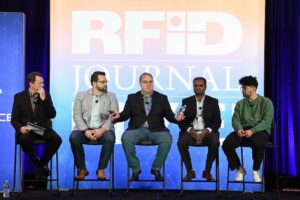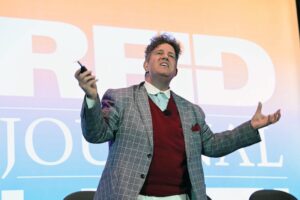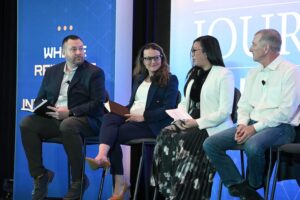Representatives of Delta Airlines, Lockheed Martin, LVMH, Sephora, and UPS discussed how businesses are being transformed by increased RFID usage.
Apr 10, 2024The first day of the RFID Journal LIVE! 2024 concluded with keynote speakers detailing why the industry is no longer just the realm of the early adopters.
From RFID and IoT to Artificial Intelligence (AI) and Machine Learning (ML) advancements, more and more companies are transforming their business with technologies that were unheard even just a few years ago.
This was exemplified by the diverse roster of speakers—Delta Airlines, Lockheed Martin, UPS, Sephora, and LVMH—that were on stage April 9.
Disruptive Technologies
Kicking off the conference was a discussion titled "Disruptive Technologies: The Future is Now," moderated by University of Memphis President Bill Hardgrave.
Brandon Woodruff, Delta Air Lines manager for airport customer service, hardware and infrastructure, detailed to attendees how RFID is revolutionizing baggage handling. The airline is leading the way in hands-free scanning of baggage, leveraging RFID technology to improve processing, reduce expenses, and enhance customer satisfaction.

Photo by Jann Hendry
“Once we deployed RFID we saw a tremendous benefit,” said Woodruff. Going forward, he expects RFID to help the airline industry as a whole as they strive "for better performance, better connectivity and better passenger experience for the entire industry. We continue to lean into RFID to build upon our existing successes."
Asset Tracking
Corey Cook, chief of Lockheed Martin Advanced Technologies Concepts, discussed the latest innovations in asset tracking technologies, spearheading the digital transformation revolution at his company. Cook noted how Lockheed is exploring integration with autonomous systems, augmented reality, holographic visualization, and self-sensing platforms.
"Its amazing how quickly this technology is rolling out,” said Cook. With hologram technology, he said “we can instantly identify where assets are in the theater and share that with all the echelons that want access to that information.”
SharpEnd founder Cameron Worth shared his insights into the world's fastest-growing IoT SaaS platform, io.tt. Worth walked the audience through strategic approaches for consumer brands to embrace connected products through IoT and connected packaging, accelerating consumer adoption.
“The business case for NFC is bigger than just engagement,” said Worth, adding "the next 12 to 18 months is building out the NFC business (as) companies have found engagement rates growing from 2 to 20 percent. “
Disruptive technology said Worth “is realization of products being shipped with embedded connectivity.”
UPS Initiative
The closing keynote was led by UPS’ Jon Gurney Bell for a panel discussion entitled “Smart Package, Smart Facility: UPS Deploying Game Changing Initiative.”
Bell went into detail about UPS groundbreaking smart package smart facility (SPSF) initiative, deploying one of the biggest RFID initiatives in corporate America. Just last week, the company noted the RFID package-tagging initiative established across company warehouses improved package flow per hour by 30 to 35 percent.

Photo by Jann Hendry
Bell explained the company strategically positioned next gen readers through a network with multiple layers of configuration and validation—the same framework being deployed with the vehicles and customers.
UPS’ smart package smart facility (SPSF) initiative, Bell stated “is about sitting at the intersection of the UPS internet of Things, We call it a package with a brain…. We believe information increases in value as it reaches decision makers.”
“UPS is making a transition from a scanning based network to sensing based network," he said. "We think the technology is transferrable, package precision, today we scan these packages."
Customer Comments
The shipping company has implemented their SPSF Next Generation Technology in their preload buildings in the U.S and in Canada, creating package location precision, improving productivity, and elevating the customer experience, while reducing their carbon footprint.

Photo by Jann Hendry
From a customer perspective, LVMH’s Amy Lio and Sephora’s’ Mike Racer shared how UPS is setting a new industry benchmark with optimized tracking, efficiency, and unparalleled customer experiences.
"We all have a problem with fraud these days and getting ahead of that and counterfeit, we now have visibility from pickup to delivery," said Lio.
Racer added “One of the biggest impacts to us is claims. At least at the package level [the RFID initiative from UPS] opens up a lot of opportunity for us, which visual proof of delivery. Now with technology like this we can trace the package all the way to the client.”

